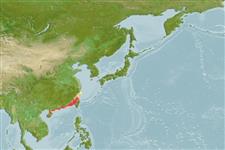Elasmobranquios (tiburones y rayas) (sharks and rays) >
Carcharhiniformes (Ground sharks) >
Hemigaleidae (Weasel sharks)
Etymology: Paragaleus: para (Gr.), near, referring to how its dentition is intermediate between Hemigaleus and the triakid Eugaleus (=Galeorhinus) (See ETYFish); tengi: In honor of Teng Huo-Tu (1911-1978), Director, Taiwan Fisheries Research Institute, and authority on Taiwanese elasmobranch fishes (See ETYFish).
Eponymy: Dr Teng Huo-Tu (1911–1978) was a Taiwanese ichthyologist. [...] (Ref. 128868), visit book page.
Environment: milieu / climate zone / depth range / distribution range
Ecología
marino demersal. Tropical; 34°N - 15°N
Distribución
Países | Áreas FAO | Ecosistemas | Ocurrencias, apariciones | Point map | Introducciones | Faunafri
Western Pacific: Japan to Viet Nam, including Hong Kong and Taiwan. Report of a record from off Madagascar may be an undescribed Paragaleus which has just recently been collected.
Tamaño / Peso / Age
Maturity: Lm ? range ? - ? cm
Max length : 88.0 cm TL macho / no sexado; (Ref. 244)
Espinas dorsales (total) : 0; Espinas anales: 0. Grey or grey-brown above, light below; no prominent markings on body and fins (Ref. 13567).
A little-known inshore shark (Ref. 13567). Viviparous (Ref. 50449). Taken in fisheries where it occurs (Ref. 13567).
Life cycle and mating behavior
Madurez | Reproducción | Puesta | Huevos | Fecundidad | Larva
Viviparous, placental (Ref. 50449). Distinct pairing with embrace (Ref. 205).
Compagno, L.J.V., 1984. FAO Species Catalogue. Vol. 4. Sharks of the world. An annotated and illustrated catalogue of shark species known to date. Part 2 - Carcharhiniformes. FAO Fish. Synop. 125(4/2):251-655. Rome: FAO. (Ref. 244)
IUCN Red List Status (Ref. 130435: Version 2024-1)
Human uses
Pesquerías: escaso valor comercial
Herramientas
Special reports
Download XML
Fuentes de Internet
Estimates based on models
Preferred temperature (Ref.
123201): 21.5 - 26.9, mean 24.7 °C (based on 164 cells).
Phylogenetic diversity index (Ref.
82804): PD
50 = 0.5664 [Uniqueness, from 0.5 = low to 2.0 = high].
Bayesian length-weight: a=0.00355 (0.00144 - 0.00875), b=3.07 (2.85 - 3.29), in cm total length, based on LWR estimates for this (Sub)family-body shape (Ref.
93245).
Nivel trófico (Ref.
69278): 4.2 ±0.6 se; based on size and trophs of closest relatives
Resiliencia (Ref.
120179): Muy bajo, población duplicada en un tiempo mínimo superior a 14 años (Fec is assumed to be <10).
Fishing Vulnerability (Ref.
59153): High vulnerability (55 of 100).
Nutrients (Ref.
124155): Calcium = 33.9 [5.5, 192.1] mg/100g; Iron = 0.731 [0.184, 2.180] mg/100g; Protein = 19 [17, 21] %; Omega3 = 0.106 [0.043, 0.251] g/100g; Selenium = 37.8 [11.6, 121.9] μg/100g; VitaminA = 28.3 [8.8, 91.8] μg/100g; Zinc = 0.848 [0.399, 1.545] mg/100g (wet weight);
